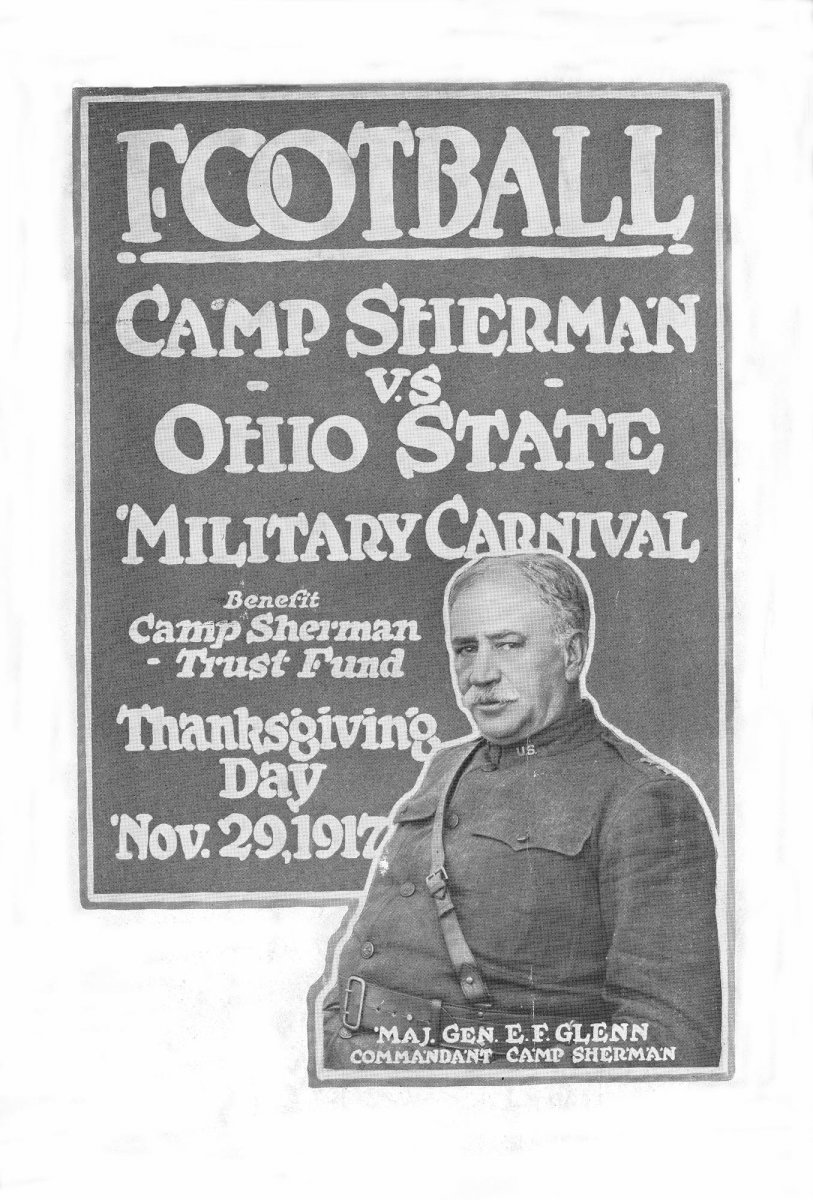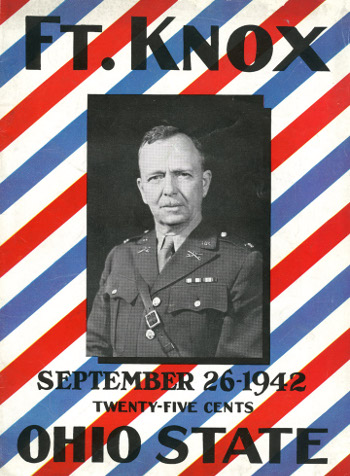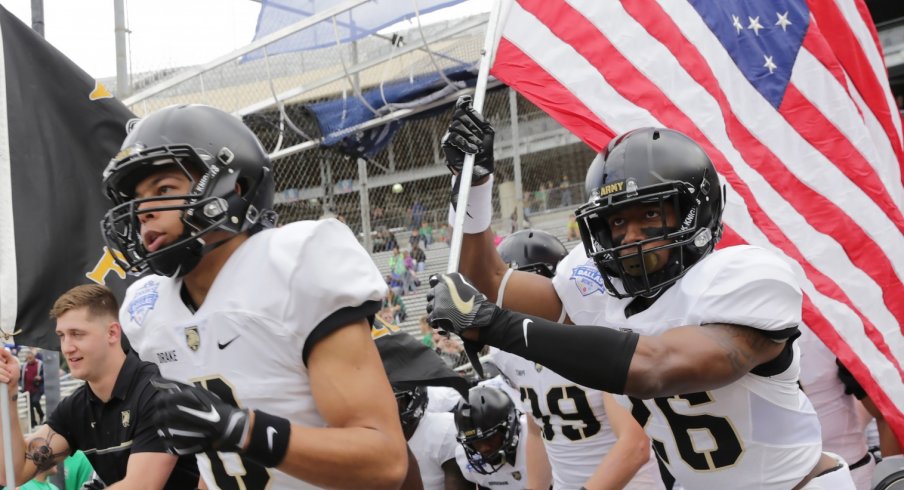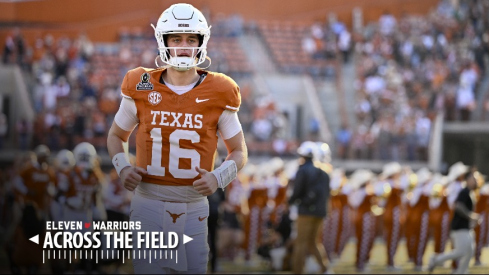Army, arguably the marquee service program in college football, will appear on Ohio State's schedule for the first time ever. Army is a historical giant in the sport, with three Heisman winners and five national championships (two of which are unclaimed by the program) to its name. As such, this matchup on Sept. 16 connotes some intrigue for fans with an appreciation for the history of the sport.
Sept. 16 will be the first game between these two programs that have combined for 13 national championships, but Ohio State's history is replete with encounters against service academies or football squads representing military institutions. The Buckeyes have played military programs on 16 different occasions, posting a 12-4 record all-time. The table details the outcomes of all these encounters in the program's entire history.
| Season | Opponent | Site | Result |
|---|---|---|---|
| 1894 | at Columbus Barracks | Recreation Park | W, 30-0 |
| 1894 | 17th Regiment | Recreation Park | W, 46-4 |
| 1896 | Columbus Barracks | Recreation Park | W, 10-2 |
| 1897 | Columbus Barracks | Recreation Park | L, 0-6 |
| 1917 | Camp Sherman | Ohio Field | W, 28-0 |
| 1930 | Navy | Municipal Stadium (Baltimore) | W, 27-0 |
| 1931 | Navy | Ohio Stadium | W, 20-0 |
| 1942 | Fort Knox | Ohio Stadium | W, 59-0 |
| 1942 | Iowa Pre-Flight | Ohio Stadium | W, 41-12 |
| 1943 | No. 8 Iowa Pre-Flight | Ohio Stadium | L, 13-28 |
| 1943 | at No. 12 Great Lakes Navy | Ross Field (Chicago) | L, 6-13 |
| 1944 | No. 6 Great Lakes Navy | Ohio Stadium | W, 26-6 |
| 1981 | Navy | Liberty Bowl | W, 31-28 |
| 1990 | Air Force | Liberty Bowl | L, 11-23 |
| 2009 | Navy | Ohio Stadium | W, 31-27 |
| 2014 | Navy | M&T Bank Stadium | W, 34-17 |
Two patterns emerge from this summary table. Over 60% of these encounters happen when Ohio State was still in its football infancy as a non-major program or in the context of the two world wars.
Ohio State fans likely know that its football origins are among the most humble for any program that we would otherwise classify now as a major power in the sport. The football was small-scale and the competition was almost exclusively regional, even local. The Buckeyes played the Columbus Barracks three times during its football infancy in the 1890s, winning the first two by a combined score of 40-2 before losing the final encounter in a 6-0 shutout.
Long-time Columbus residents may recognize the former Columbus Barracks as Fort Hayes. The facility has evolved over time and the military installment there relocated to a new complex in nearby Whitehall. At the time, the U.S. military used the complex as an academic institution to train and educate select recruits. The barracks fielded a football program in those years and even played local professional teams.
The complex also hosted the 17th Infantry from 1894 to 1899. Military buffs may remember that Congress created the 17th Infantry in 1812 as a regular Army regiment comprised of personnel from territory northwest of the Ohio river (i.e. the Northwest Territory). Ohio State played a football team representing the 17th Infantry in the same season it played recruits from the Columbus Barracks. The Buckeyes won that contest handily, 46-4.
Contests against these programs end in the seasons that follow. Ohio State joined the Western Conference (i.e. Big Ten), effectively turning the Buckeyes from non-major program to major program. The competition evolved from local to regional as a result. Several of these institutions also dropped their football programs.

During this transition to major program status, the Buckeyes hosted a football squad from Camp Sherman to end the 1917 season. This game is a conspicuous entry in Ohio State football lore. Camp Sherman emerged as a military installation in Chillicothe as the United States entered World War I late into that conflict. Five days after a trip to Montgomery to play Auburn, the Buckeyes hosted a squad from Camp Sherman in a "Military Carnival," effectively a post-season exhibition game on Thanksgiving Day.
The Camp Sherman squad itself featured several players drafted into the conflict from other college football programs. The captain was even James Garfield's grandson, a former gridiron star at Williams College. The Buckeyes needed little effort to dispatch the Camp Sherman squad by a final score of 28-0.
The inter-war years saw Ohio State start a home-and-home series with Navy, which was just four years after the 1926 national championship year for the Midshipmen. The Buckeyes won the first game in Baltimore in 1930, a convincing 27-0 win for Sam Willaman's team. Ohio State won the follow-up in Ohio Stadium, 20-0, in 1931.
Without trivializing the stakes involved in World War II, one externality of the U.S. mobilization in that war involved college football. Several military programs emerged that, considering conscription, afforded these programs a wealth of talent for the football programs they would also field. These armed forces football programs would all be mainstays in the AP College Football Poll for the remaining years of the war.
Ohio State played two of these programs in 1942. The first, the Fort Knox Armoraiders, visited Ohio Stadium to open the 1942 season. The Armoraiders, albeit a smaller program, were still able to conscript in players from programs like Alabama, LSU, Michigan State, and Minnesota. However, the Buckeyes had no difficulty manhandling the smaller Armoraiders, 59-0.

Ohio State played the Iowa Pre-Flight Seahawks, representing the U.S. Naval Pre-Flight School at the University of Iowa, to conclude the 1942 season. The pre-flight school at the University of Iowa was one of several the U.S. Navy commissioned in 1942, with others at the University of Georgia, University of North Carolina, and Saint Mary's College in California. The Iowa Pre-Flight program happened to have a loaded football program coached by Bernie Bierman, the guy who made Minnesota an unbeatable juggernaut with five national championships in 1934, 1935, 1936, 1940, and 1941. Ohio State won the first encounter, 41-12, to conclude a season in which Ohio State won its first national championship.
Don Faurot, of Missouri fame, replaced Bernie Bierman for the 1943 season and improved on what Bierman did the previous year. The Buckeyes' fortunes in 1943 turned south in what would be Paul Brown's final year in Columbus. The Buckeyes lost the season-opener against Iowa Pre-Flight by 15 points. It later traveled to Chicago to play the Great Lakes Navy Bluejackets, which represented the boot camp at Naval Station Great Lakes. The Buckeyes lost that contest, 13-6.
Ohio State finished 1943 with a 3-6 record. Iowa Pre-Flight and Great Lakes Navy finished at No. 2 and No. 6 in the AP Top 25. They were two of seven armed services programs to place in the final AP Poll that year.
The Buckeyes did not play Iowa Pre-Flight again, but hosted Great Lakes Navy in 1944. This was one of the Buckeyes' marquee matchups, pitting the No. 4 Buckeyes against the No. 6 Bluejackets. Ohio State won by 20 points, giving the Bluejackets just one of their two losses on the season.
The Bluejackets finished at No. 17 in the final AP Poll. The Buckeyes, under first-year coach Carroll Widdoes, fared much better. The Buckeyes went undefeated with Heisman winner Les Horvath as captain, winning what amounted to the "civilian" national championship in 1944. Army, which demolished every team in its path by an average score of 56-3, won the AP and national championship distinctions from most other selectors that year.
The conclusion of World War II ends most of these auxiliary football programs, though Ohio State continued to see service academies on its schedule on rare occasions. The next two encounters were in the Liberty Bowl almost ten years apart. The Buckeyes concluded a somewhat disappointing 1981 season, including Art Schlichter's swan song at Ohio State, with a 31-28 win over the Midshipmen in Memphis. The defensive difficulties for that bowl game, coupled with the defense's overall problems since the 1980 opener against Syracuse, led to what Ohio State writers would later term the "New Year's Eve Massacre." Earle Bruce fired his entire defensive staff, which included a young defensive backs coach named Nick Saban.
Ohio State's next trip to the Liberty Bowl came against another service academy, though the result was far uglier. Air Force, a 6-5-1 squad, overwhelmed the No. 24 Buckeyes. Ohio State's offense never gained any traction. Robert Smith only mustered 62 yards on the ground and Greg Frey, in his final game for the Buckeyes, went 10/27 for 110 yards and an interception. John Cooper yanked him late in the contest for Kent Graham.
Ohio State's most recent two contests against service programs were the home-and-home series against Navy to open the 2009 and 2014 seasons. Ohio State hosted Navy in 2009 in a nail-biter. Navy scored a touchdown to cut Ohio State's lead to 29-27 with 2:23 remaining in the fourth quarter. Brian Rolle, however, intercepted the ensuing two-point try and returned it for two points. This became the final margin of that contest. The 2014 return leg in Baltimore, a 34-17 win for the Buckeyes, was not as close, though featured important growing pains as Ohio State adjusted to life without Braxton Miller at quarterback.
The Buckeyes will welcome the Army Black Knights with considerable fanfare on Sept. 16. It will be the first-ever matchup between the two and Ohio State will treat Army with the same pomp and circumstance it gave Navy when the Midshipmen visited in 2009. However, this historical first between two tradition-rich historical powers belies a long history between Ohio State and football programs from U.S. military institutions that is more than just a five-game series with Navy. The Buckeyes are no strangers to playing these programs and the Army game will ultimately be another installment in a long history that dates to Ohio State's football infancy.


